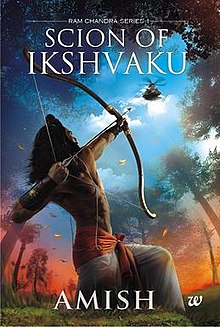The Scion of Ikshvaku (Ram Chandra series book #1) by Amish Tripathi


Genre:
Mythological fiction
Pages: 354
Format:
paperback
Publisher:
Westland Publications private limited
Year of
publication: 2015
I would
like to begin by saying that the author has only taken the lead characters and
the basic setting from the epic Ramayana. So instead of categorizing this book
to be a re-telling of Ramayana, I would more aptly call it a re-imagining of
the epic.
REVIEW:
Plot
The basic
plot is of Ramayana, but with numerous distortions (which is alright, as the author never claims that he's rewriting the epic...it is after all, fiction) Quite contrary to the fact
that the exposition and the plot building was one of the best things of Amish’s
Shiva trilogy; this series has a very
slow and boring exposition. In the first half of the book, nothing much happens
except for the defeat of Dashrath by his foe, Raavan. The stay of Ram and his
brothers in the gurukul is astonishingly uneventful and full of discussions
between guru Vashistha and his pupils -which may have philosophical importance,
but is poorly put up. We soon come to know that Vashistha is allying with the Nagas
( a mysterious, deformed race of people in the land)…but there is little
development of that sub plot. The bottom-line is that the book fails to give
food for thought and doesn’t provide suspense at all. I found the book
interesting only when I was halfway through it.
Here I would
point out the narrative structure of this series. The books are written in a
style called multi-linear narrative (as clarified by Amish himself). Quoting him
: “In such a narrative, there are many characters; and a connection brings them
all together. The three main characters are Ram, Sita and Raavan. Each
character has life experiences which mould who they are and their stories
converge with the kidnapping of Sita. And each has their own adventure and back
story.”
'Scion of
Ikshvaku’ is a glimpse of the life of Ram and Ram only. This suggests that the
author will intentionally skip essential details of the other characters due to
the fact that they have separate books to cater to their own story—which is a major
issue this book suffers from. The plot sometimes advances in leaps, skipping
over portions of the story…while sometimes it’s barely unfolding. The transition
of Ram from an adolescent to an adult, both psychologically and emotionally, hasn’t
been worked upon—resulting in conflicts between the reader’s perception about
him and what the author actually writes. When Ram arrives in Mithila, we suddenly find that Sita wants him to win her hand. Moreover, the swayamvar ceremony
in which he participates is a complete copy of Draupadi’s swayamvar in
Mahabharata. Amish has changed the reason why Ram has to leave for his exile,
and the reason proposed in the story is not convincing enough. Many such areas
of the plot are not concrete. Some of the distortions from the main epic are extremely
forceful, which adds to the author’s discredit.
Characterisation:
Sita’s
role in the first book is not much, and we constantly feel the need of other
strong characters. Unfortunately, Ram’s character building is not very striking
and the author only explores certain predictable aspects of his personality. The
character of Kaikeyi (Dasrath’s beloved wife and the one who saved his life in
the battle with Raavan) is very casually established. She ought to have come about
as a very powerful influence in the story, but surprisingly does not. Even the
character of Dashrath is not well thought of. Laskhman comes about as a
protective and amiable person—and his relationship with his elder brother Ram
is commendable and well-constructed. The author also successfully stimulates opinions
and emotions against Raavan, who has a major role to play as the story moves
ahead.
Another issue
is the character hierarchy. Ram and Sita are the protagonists and all the other
characters are on the same flat level— where they can’t be called as protagonists
as they do not entirely dominate the plot, neither can they be ruled out as
they have roles occasionally. They all continue to remain not-so-important throughout
the book. There is no rise and fall of the characters, no incidents that change
their outlook and they do not compete at all to have a crucial place for
themselves in the plot.
My
views:
The bottom
line is—the book has been poorly executed. The first book of any series should
essentially be very well written; so as to hold the reader’s interest in the
upcoming sequels. But this book fails to do so. The consistency of the writing is
also not very good. Sometimes the author pushes the plot forward quite fast,
whereas in some portions he slows down considerably and goes on giving endless
backstories and descriptions of everything around. The book goes better as it advances, which is
quite unexpected from an author like Amish, who has written one bestsellers
after another.
RECOMMENDATIONS:
I will
recommend this book to mature readers. People should read it especially
because the sequels are better. The next book in this series ; ‘Sita: Warrior
of Mithila’ outshines this book.





Post a Comment